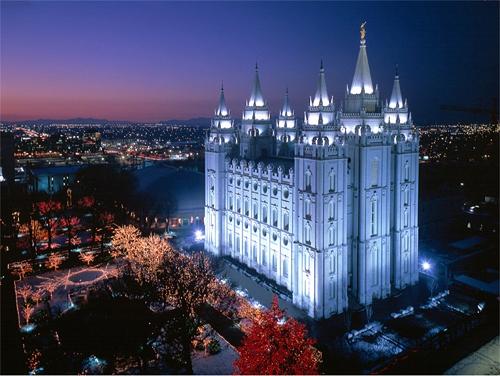 Something that often confuses people learning about The Church of Jesus Christ of Latter-day Saints (the “Mormons”) is the difference between Mormon chapels and Mormon temples. Both are important buildings in Latter-day Saint worship. Chapels are meetinghouses for local congregations. These might also be called “ward buildings” (a “ward” being a local congregation), “meetinghouses,” or simply “churches.” When a Latter-day Saint says he’s going to church, he means that he’s going to attend regular worship services at his local meetinghouse. Regular services are held here on Sundays, and they include sacrament meeting, during which all members of the congregation gather and partake of the sacrament (similar to communion). There are also classes for the children, for the youth, and for the adults.
Something that often confuses people learning about The Church of Jesus Christ of Latter-day Saints (the “Mormons”) is the difference between Mormon chapels and Mormon temples. Both are important buildings in Latter-day Saint worship. Chapels are meetinghouses for local congregations. These might also be called “ward buildings” (a “ward” being a local congregation), “meetinghouses,” or simply “churches.” When a Latter-day Saint says he’s going to church, he means that he’s going to attend regular worship services at his local meetinghouse. Regular services are held here on Sundays, and they include sacrament meeting, during which all members of the congregation gather and partake of the sacrament (similar to communion). There are also classes for the children, for the youth, and for the adults.
Local chapels are widely available in many parts of the world today. The latest numbers available at www.lds.org show that there are 27,475 local congregations of the Church today. Many of them share meetinghouses with nearby congregations, so the number of local chapels would be substantially smaller than this. Nevertheless, most larger cities in the United States today either have one or more wards or have one nearby.
But Mormon temples are less common. There are just over 120 Latter-day Saint temples in operation worldwide today. While this is a huge number in comparison with times past — just as an example, there were only about 20 temples in operation worldwide a generation ago — this is still a relatively small number. Hence, when a Latter-day Saint temple is built and dedicated, it’s an occasion that receives widespread notice.
Another reason for the media buzz generated by the building of temples is that after the dedication of these temples, they are only open to faithful Latter-day Saints. This spurs some natural curiosity and speculation regarding what goes on inside them. The Mormon temples of the Lord are sacred places where we are able to make further covenants with the Lord and receive guidance and inspiration from Him. For those who are not living their lives in accordance with the Lord’s commandments, or for those who are merely curious, to enter the Mormon temples would detract from the sacredness of the places. “It is not a matter of secrecy. It is a matter of sanctity,” says President Gordon B. Hinckley, who was serving as the prophet of The Church of Jesus Christ of Latter-day Saints at the time of his death on January 27. (“Why These Temples?” Available at www.lds.org)
President Hinckley continues:
The work that goes on in these buildings sets forth God’s eternal purposes with reference to man—God’s child and creation. For the most part, temple work is concerned with the family, with each of us as members of God’s eternal family and with each of us as members of earthly families. It is concerned with the sanctity and eternal nature of the marriage covenant and family relationships.
It affirms that each man and woman born into the world is a child of God, endowed with something of His divine nature. The repetition of th
ese basic and fundamental teachings has a salutary effect upon those who receive them, for as the doctrine is enunciated in language both beautiful and impressive, the participant comes to realize that since every man and woman is a child of Heavenly Father, then each is a member of a divine family; hence, every person is his brother or sister. (President Gordon B. Hinckley, “Why These Temples?”)
Open houses are usually held before Mormon temples are dedicated, thus giving the public the opportunity to see what they look like inside and to learn about what goes on in there. For more information on one such open house that recently took place, read “Mormon Temple Open House in Idaho,” posted previously on LDSBlogs.com.


